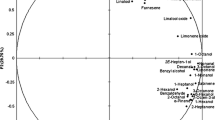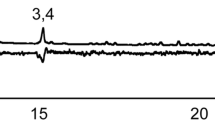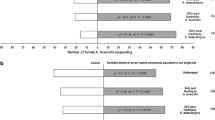Abstract
Volatiles released from fruiting bodies of the polypores Fomitopsis pinicola and Fomes fomentarius (Polyporaceae) were collected by entrainment and SPME techniques and analyzed by GC-MS. The most significant difference between the two species was found in the terpene fraction. F. fomentarius emitted a more complex blend, with more than 10 sesquiterpenes. During the sporulating phase, the release of (R)- and (S)-oct-1-en-3-ol, octan-3-one, and some sesquiterpene hydrocarbons (mainly β-barbatene) increased in F. pinicola, whereas in F. fomentarius the release of octan-3-one, cis-furanoid linalool oxide, β-phellandrene, β-myrcene, and several sesquiterpene hydrocarbons increased. β-Barbatene was identified for the first time in fungi. Chopping of the fruiting bodies altered the odor composition more in F. fomentarius than in F. pinicola. Five volatiles giving a typical fungal odor (rac-oct-1-en-3-ol, nonan-1-ol, rac-octan-3-ol, octan-1-ol, and octan-3-one) were tested for insect attraction in the field. Females of the three wood-living generalist beetles Malthodes fuscus, Anaspis marginicollis, and A. rufilabris and both sexes of the moth Epinotia tedella were attracted to rac-oct-1-en-3-ol. The generalist predator on fungus-insects Lordithon lunulatus was attracted to rac-oct-1-en-3-ol and octan-3-one in combination. Previous results regarding the host-specific attraction of beetles to the odors emanating from chopped fruiting bodies of F. pinicola and F. fomentarius are discussed in the light of this investigation.
Similar content being viewed by others
REFERENCES
Abraham, B., and Berger, R. G. 1994. Higher fungi for generating aroma components through novel technologies. J. Agric. Food Chem. 42:2344-2348.
Andersen, N. H., Costin, C. R., Kramer, M., and Ohta, Y. 1973. Sesquiterpenes of Barbilophozia species. Phytochemistry 12:2709-2716.
Barklund, P. 1987. Occurrence and pathogenicity of Lophodermium piciae appearing as endophyte in needles of Picea abies. Trans. Br. Mycol. Soc. 89(3):307-313.
Bax, A., and Summers, M. F. 1986. 1H and 13C assignments from sensitivity-enhanced detection of heteronuclear multiple-bond connectivity by 2D multiple quantum NMR. J. Am. Chem. Soc. 108:2093-2094.
Bengtsson, G., Hedlund, K., and Rundgren, S. 1991. Selective odor perception in the soil Collembola. J. Chem. Ecol. 17(11): 2113-2125.
Bernays, E. A., and Chapman, R. F. 1994. Host-Plant Selection by Phytophagous Insects. Chapman & Hall, New York.
Bodenhausen, G., and Ruben, D. J. 1980. Natural abundance nitrogen-15 NMR by enhanced heteronuclear spectroscopy. Chem. Phys. Lett. 69:185-188.
Borg-Karlson, A.-K. 1990. Chemical and ethological studies of pollination in the genus Ophrys (Orchidaceae). Phytochemistry 29(5):1359-1387.
Borg-Karlson, A.-K., and Mozuraitis, R. 1996. Solid phase microextraction technique used for collecting semiochemicals. Z. Naturforsch. 51c:599-602.
Borg-Karlson, A.-K., LindstrÖm, M., Norin, T., Persson, M., and ValterovÁ, I. 1993. Enantiomeric composition of monoterpene hydrocarbons in different tissues of Norway spruce Picea abies (L.) Karst. A multi-dimensional gas chromatography study. Phytochemistry 33(2):303-307.
Borg-Karlson, A.-K., Unelius, C. R., and Nilsson, L. A. 1996. Floral fragrances chemistry in the early flowering shrub Daphne mezereum. Phytochemistry 41(6):1477-1483.
BÖrjesson, T. S., StÖllman, U. M., and SchnÜrer, J. L. 1993. Off-odorous compounds produced by molds on oatmeal agar: Identification and relation to other growth characteristics. J. Agric. Food Chem. 41:2104-2111.
Braun, S., Kalinowski, H.-O., and Berger, S. 1996. 100 and more basic NMR experiments. A practical course. VCH, Weinheim.
Clark, C. L., Miller, J. D., and Whitney, N. J. 1989. Toxicity of conifer needles endophytes to spruce budworm. Mycol. Res. 93(4):508-512.
Gallois, A., Gross, B., Lanlois, D., Spinnler, H.-E., and Brunerie, P. 1990. Influence of culture conditions on production of flavour compounds by ligninolytic basidiomycetes. Mycol. Res. 94(4):494-504.
HÅgvar, S., and Økland, B. 1997. Saproxylic beetle fauna associated with living sporocarps of Fomitopsis pinicola (Fr.) Karst. in four spruce forests with different management histories. Fauna Norv. B 44:95-105.
Hansen, O. C. 1987. Grannålevikler på rödgran. PhD dissertation. Department of Population Biology, University of Copenhagen, Copenhagen.
Hansen, V. 1964. Fortegnelse over Danmarks biller 1. og 2. del. (Catalogue of the Coleoptera of Denmark 1st and 2nd part). Entomol. Medd. 33(1–2):1-507.
Hanski, I. 1989. Fungivory: fungi, insects and ecology. pp. 25-68, in N. Wilding, N. M. Collins, P. M. Hammond, and J. F. Webber (eds.). Insect-Fungus Interactions. Academic Press. London.
Hanssen, H.-P., Sinnwell, V., and Abraham, W.-R. 1986. Volatile fragrance compounds from the fungus Gleophyllum odoratum. Z. Naturforsch. 41(9–10):825-829.
Harrington, T. C., Furniss, M. M., and Shaw, C. G. 1981. Dissemination of Hymenomycetes by Dendroctonus pseudotsugae (Coleoptera, Scolytidae). Phytopathology 71:551-554.
Honda, H., Ishiwatari, T., and Matsumoto, Y. 1988. Fungal volatiles as oviposition attractants for the yellow peach moth, Conogethes punctiferalis (Guenée) (Lepidoptera; Pyralidae). J. Insect Physiol. 34(3):205-211.
Jonsell, M, and Nordlander, G. 1995. Field attraction of Coleoptera to odours of the wooddecaying polypores Fomitopsis pinicola and Fomes fomentarius. Ann. Zool. Fenn. 32:391-402.
Jonsson, M., Nordlander, G., and Jonsell, M. 1997. Pheromones affecting flying beetles colonizing the polypores Fomes fomentarius and Fomitopsis pinicola. Entomol. Fenn. 8:161-165.
Kaminski, E., Stawicki, S., Wasowicz, E., and Kasperek, M. 1980. Volatile odour substances produced by microflora. Nahrung 24(2):103-113.
KÖnig, W. A., Riek, A., Saritas, Y., Hardt, I. H., and Kubeczka, K.-H. 1996. Sesquiterpene hydrocarbons in the essential oil of Meum athamanticum. Phytochemistry 42(2):461-464.
Matsuo, A., Nakayama, N., and Nakayama, M. 1985. Enantiomeric type sesquiterpenoids of the liverwort Marchantia polymorpha. Phytochemistry 24(4):777-781.
Matthewman, W. G., and Pielou, D. P. 1971. Arthropods inhabiting the sporophores of Fomes fomentarius (Polyporacae) in Gatineau Park, Quebec. Can. Entomol. 103(6):775-847.
MÜnster-Swendsen, M. 1989. Phenology and natural mortalities of the fir needleminer, Epinotia fraternana (Hw.) (Lepidoptera, Tortricidae). Entomol. Medd. 57:111-120.
Nuss, I. 1975. Zur Ökologie der Porlinge. Bibliotheca Mycologica. Vaduz. J. Cramer. 45.
Pacioni, G., Bologna, M. A., and Laurenzi, M. 1991. Insect attraction by Tuber: A chemical explanation. Mycol. Res. 95(12):1359-1363.
Palm, T. 1959. Die Holz-und Rindenkäfer der Süd-und Mittelschwedischen Laubbäume. Opusc. Entomol. Suppl. 16:374 pp.
Persson, M., SjÖdin, K., Borg-Karlson, A.-K., Norin, T., and Ekberg, I. 1996. Relative amounts of enantiomeric composition of monoterpene hydrocarbons in xylem and needles of Picea abies. Phytochemistry 42(5):1289-1297.
Pfeil, R. M., and Mumma, R. O. 1993. Bioassay for evaluating attraction of the phorid fly, Megaselia halterata to compost colonized by the commercial mushroom, Agaricus bisporus and to 1-octen-3-ol and 3-octanone. Entomol. Exp. Appl. 69:137-144.
Phelan, L. P., and Lin, H. 1991. Chemical characterization of fruit and fungal volatiles attractive to dried-fruit beetle Carpophilus hemipterus (L.) (Coleoptera: Nitidulidae). J. Chem. Ecol. 17(6):1253-1262.
Pierce, A. M., Jr. H. D. P., Oehlschlager, A. C. and Borden, J. H. 1991. 1-octen-3-ol, attractive semiochemical for foreign grain beetle, Ahasverus advena (Waltl) (Coleoptera: Cucujidae). J. Chem. Ecol. 17(3):567-580.
Priesner, E., Reed, D. W., Underhill, E. W., and BogenschÜtz, H. 1989. (Z, Z)-7,9-Dodecadienyl acetate, sex pheromone of Epinotia tedella Clerck (Lepidoptera: Tortricidae). J. Chem. Ecol. 15:2457-2464.
Pyysalo, H. 1976. Identification of volatile compounds in seven edible fresh mushrooms. Acta Chem. Scand. B 30(3):235-244.
Reif, B., KÖck, M., Kerssebaum, R., Kang, H., Fenical, W., and Greisinger, C. 1996. ADE-QUATE, a new set of experiments to determine the constitution of small molecules at natural abundance. J. Magn. Reson. A 118:282-285.
Roelofs, W. L., and Brown, R. L. 1982. Pheromones and evolutionary relationships of Tortricidae. Annu. Rev. Ecol. Syst. 13:395-422.
Silfverberg, H. 1992. Enumeratio Coleopterorum Fennoscandiae, Daniae et Baltiae. Helsinki. Helsingin Hyönteisvaihtoyhdistys.
Soukup, F. 1987. Príspevek k poznání sporulace nekterych chorosu (Study of sporulation of some polypores). Lesnictvi 33(2):145-158.
Turner, W. B., and Aldridge, D. C. 1993. Terpenes and Steroids. Fungal Metabolites II. Academic Press, London.
ValterovÁ, I., Unelius, C. R., VrkoĆ, J., and Norin, T. 1992. Enantiomeric composition of monoterpene hydrocarbons from the liverwort Conocephalum conicum. Phytochemistry 31(9):3121-3123.
Wold, S., Albano, C., Dunn, W. J., III, Esbensen, K., SjÖstrÖm, M., Skagerberg, B. WikstrÖm, C., and Öhman, J. 1985. Multivariate data analysis: Converting chemical data tables to plots. Proceedings VIth ICCR, Garmixh. Intell. Instrum. Comput. Sept–Oct:197.
Zar, J. H. 1984. Biostatistical Analysis, 2nd ed. Prentice-Hall, Englewood Cliffs, New Jersey.
Zhang, Z., and Pawliszyn, J. 1993. Headspace solidphase microextraction. Anal. Chem. 65:1843-1852.
Author information
Authors and Affiliations
Rights and permissions
About this article
Cite this article
Fäldt, J., Jonsell, M., Nordlander, G. et al. Volatiles of Bracket Fungi Fomitopsis pinicola and Fomes fomentarius and Their Functions as Insect Attractants. J Chem Ecol 25, 567–590 (1999). https://doi.org/10.1023/A:1020958005023
Issue Date:
DOI: https://doi.org/10.1023/A:1020958005023




